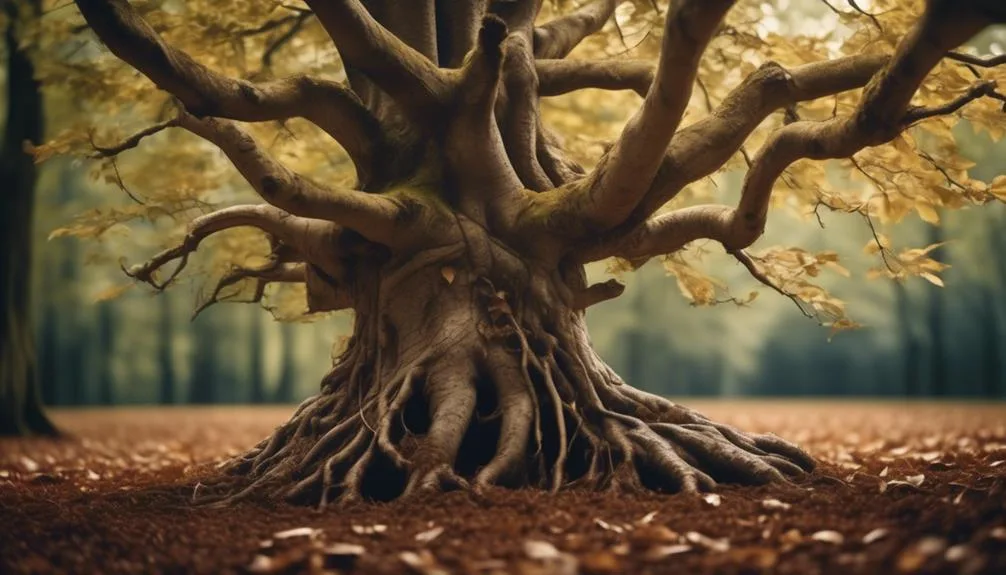Beech trees are known for their deep roots. You might be curious about why this is. The reason behind it is their ability to adapt to different soil conditions. These deep roots help the trees in absorbing water and nutrients. They also provide support, stability, and compete for resources with other plants.
Understanding the purpose of these deep roots reveals the fascinating and essential role they play in the survival of beech trees.
Adaptation to Soil Conditions
Beech trees adapt to a variety of soil conditions by sending their roots deep into the earth, allowing them to thrive in diverse environments. Their root architecture enables them to penetrate various soil compositions, from clay to loam, by growing a network of fine, fibrous roots close to the surface and larger, anchoring roots that delve deep into the ground.
This allows beech trees to access water and nutrients effectively, even in nutrient-poor or compacted soils. The extensive root system also provides stability and support, especially in windy or stormy conditions. Additionally, the deep roots help in preventing soil erosion by holding the soil together.
This adaptive feature of beech trees showcases their resilience and ability to flourish in a wide range of soil types, making them an integral part of many forest ecosystems.
Water and Nutrient Absorption
To effectively absorb water and nutrients, beech trees utilize their extensive root system, featuring a network of fine, fibrous roots near the surface and larger, anchoring roots that penetrate deep into the ground. This intricate root structure enables efficient nutrient uptake and water absorption from the surrounding soil. The fine, fibrous roots near the surface are responsible for nutrient uptake, while the larger, anchoring roots delve deep into the soil, ensuring the tree's stability and aiding in water absorption. This dual root development allows beech trees to thrive in various soil conditions, including nutrient-poor or compacted soils. The following table illustrates the key roles of different root types in water and nutrient absorption:
| Root Type | Function |
|---|---|
| Fine, fibrous roots | Nutrient uptake from the soil |
| Larger, anchoring roots | Stability and water absorption |
Beech trees' root system is crucial for their survival and ability to thrive in diverse environments.
Structural Support and Stability
With a network of fine, fibrous roots near the surface and larger, anchoring roots that penetrate deep into the ground, beech trees ensure their structural support and stability. The anchoring roots play a crucial role in providing wind resistance and preventing the tree from toppling over during strong winds or storms. These deep roots act as a robust anchor, firmly securing the tree in place.
Additionally, the extensive root system of beech trees aids in erosion prevention and soil retention. By binding the soil together, the roots help to stabilize the ground, reducing the risk of erosion.
This structural support not only benefits the tree itself but also contributes to the overall health of the surrounding ecosystem by maintaining soil integrity and stability.
Environmental Competition
In the densely populated forest, beech trees compete vigorously for resources such as sunlight, water, and nutrients, employing various strategies to secure their survival and growth.
Resource competition among beech trees is intense, driving them to develop intricate root architectures to access essential elements for their sustenance. Their root systems often extend deeply into the soil, allowing them to tap into water reservoirs and compete effectively for this precious resource.
Furthermore, beech trees exhibit a wide lateral root spread, enabling them to maximize nutrient uptake and outcompete neighboring plants. This competitive edge in resource acquisition is crucial for the beech trees' ability to thrive in densely populated forests, where environmental competition is fierce.
The intricate root architecture of beech trees reflects their relentless drive to secure the necessary resources for their survival and growth in their competitive woodland habitat.
Seasonal Changes and Survival
As seasonal changes unfold, beech trees adapt their physiological processes to ensure survival in the face of shifting environmental conditions. This remarkable adaptation allows them to thrive in a range of climates and ecosystems. Here's how they navigate seasonal changes:
- Root Growth: Beech trees adjust their root growth patterns in response to seasonal variations. During colder months, they focus on deepening their roots to access water stored in lower soil layers, while in warmer months, they extend their roots nearer to the surface to capture moisture from rainfall.
- Tree Physiology: Beech trees modify their physiological functions, such as photosynthesis and water retention, to accommodate seasonal fluctuations. In winter, they conserve energy by reducing metabolic processes, and in spring and summer, they ramp up photosynthesis to maximize growth and survival.
Conclusion
In essence, the deep roots of beech trees are their silent guardians, enabling them to weather challenges, find sustenance, and stand resilient amid the ebb and flow of nature.
Their understated strength symbolizes the enduring resilience and adaptability necessary for thriving in the ever-changing world.

My interest in trees started when I first saw the giant sequoias in Yosemite.
I was a teenager then, and I remember thinking, “I need to learn more about this.”
That moment stuck with me.
A few years later, I went on to study forestry at Michigan Tech.
Since graduating, I’ve worked in a mix of hands-on tree care and community education.
I’ve spent over ten years helping people understand how to plant, maintain, and protect the trees in their neighborhoods.
I don’t see trees as just part of the landscape.
They are living things that make a real difference in our daily lives.
